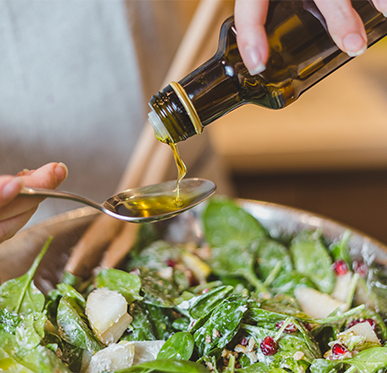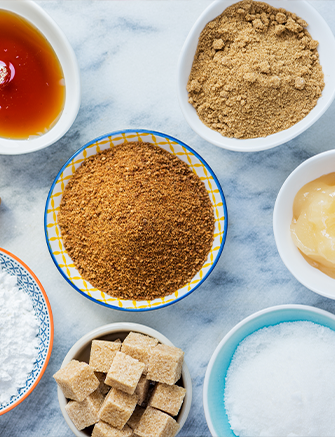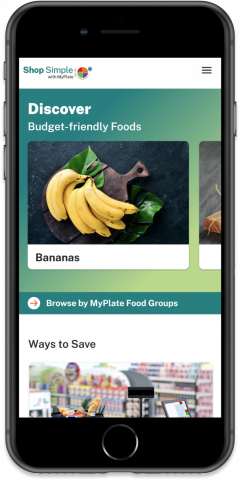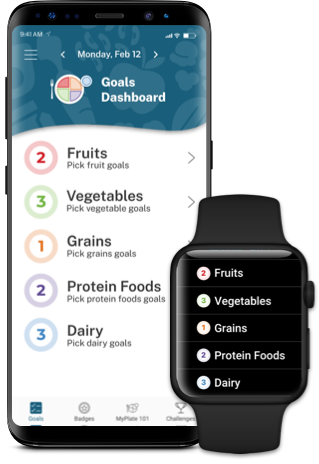More Key Topics
Explore Each of the Key Topics
About Oils
Oils are fats that are liquid at room temperature, like vegetable oils used in cooking. They come from many different plants and from fish. Oils are not a food group, but they provide you with important nutrients such as unsaturated fats and vitamin E. Choosing unsaturated fat in place of saturated fat can reduce your risk of heart disease and improve “good” (HDL) cholesterol levels.

Sources of Oils
Many foods supply oils, like nuts, olives, some fish, and avocados. Most oils are high in monounsaturated fats or polyunsaturated fats, which are healthy fats, and low in saturated fats. Foods that are mainly made of oil include mayonnaise, certain salad dressings, and soft margarine that comes in a tub or can be squeezed from a bottle.
The fat from some tropical plants like coconut oil, palm oil, and palm kernel oil are not included in the oils category because they are higher in saturated fats than other oils. They can be thought of as solid fats. Solid fats are fats that are solid at room temperature, like butter, lard and shortening. Solid fats come from many animal foods and can be made from vegetable oils.
For some helpful tips, check out the Rethink Fats tip sheet.
|
Canola oil |
Safflower oil |
| Corn oil | Sesame oil* |
| Cottonseed oil | Soybean oil |
| Grapeseed oil | Sunflower oil |
| Olive oil | Walnut oil* |
| Peanut oil |
*mainly used as flavoring
Limit Added Sugars
Added sugars are sugars and syrups that are added to foods or beverages when they are made. This does not include sugars found in milk and fruits.
To build healthy eating habits and stay within calorie needs, people over age 2 should eat foods and drink beverages with little or no added sugars. Children under age 2 should not have them at all.

- beverages, such as regular soft drinks, energy or sports drinks, fruit drinks, sweetened coffee and tea
- breakfast cereals and bars
- cakes
- candy
- cookies and brownies
- ice cream and dairy desserts
- pies and cobblers
- sugars, jams, syrups, and sweet toppings
- sweet rolls, pastries, and donuts
Reading the ingredient label on packaged foods can help you identify added sugars.
| anhydrous dextrose | fructose | molasses |
| brown rice syrup | fruit nectar | pancake syrup |
| brown sugar | glucose | raw sugar |
| cane juice | high-fructose corn syrup (HFCS) | sucrose |
| confectioner's powdered sugar | honey | sugar |
| corn syrup | invert sugar | sugar came juice |
| crystal dextrose | liquid fructose | white granulated sugar |
| dextrose | malt syrup | evaporated corn sweetener |
| maple syrup |
For some helpful tips, check out the Cut Back on Added Sugars tip sheet.
Limit Saturated Fat
Saturated fat is often found in forms that are solid at room temperature. Examples of these include milk fat, butter, or the fat inside or around meat. A few food products such as coconut oil, palm oils, or whole milk remain as liquids at room temperature but are high in saturated fat.
Cut back on saturated fat by replacing foods high in saturated fat with foods higher in unsaturated fat. Some foods that are high in saturated fat are:
- Desserts and baked goods, such as cakes, cookies, donuts, pastries, and croissants
- Many cheeses and foods with cheese, like pizza, burgers, and sandwiches
- Sausage, hot dogs, bacon, and ribs
- Fried potatoes (French fries) if fried in saturated fat or hydrogenated oil
- Regular ground beef (like 85% lean) and cuts of meat with fat you can see
- Fried chicken and other chicken dishes with the skin
- Whole milk and full-fat dairy foods and desserts
For some helpful tips, check out the Rethink Fats tip sheet.

| Beef fat (tallow, suet) | Butter | Chicken fat |
| Coconut oil | Cream | Hydrogenated oils** |
| Milk fat | Palm and palm kernel oils | Partially hydrogenated oils** |
| Pork fat (lard) | Shortening | Stick margarine |
Limit Sodium
Most people ages 14 years and older should not consume more than 2,300 mg of sodium (salt) per day. Children younger than 13 years of age should have less than this amount.
The effect of sodium on your blood pressure is well-known. The more sodium you take in, the higher your blood pressure rises. Research shows that limiting sodium may reduce a person’s risk for heart disease and high blood pressure (also known as hypertension).
- Mixed dishes, such as pizzas, burgers, casseroles, tacos, and sandwiches
- Processed meats, poultry, and seafood — like deli meats, sausages, pepperoni, and sardines
- Sauces, dressings, and condiments
- Instant products like flavored rice, instant noodles, ready-made pasta and frozen entrées

Sodium is found in many of the foods we eat and most of us get more than we need. Adding salt to food is one source of sodium but it is often not the main reason for high sodium intake. Sodium is already added to a lot of the foods we buy and dishes we order. You can lower the amount of sodium you eat and drink with these tips:
- Use the Nutrition Facts label to compare the sodium in packaged foods and beverages. Choose products with less sodium.
- Buy low-sodium, reduced sodium, or no-salt-added products.
- Look for fresh, frozen, or canned vegetables without added sauces or seasonings.
- Choose fresh or frozen poultry, seafood, and lean meats instead of prepared or ready-to-eat products. This way you can control the amount of salt you add.
- Cook at home more often to control the sodium in your food.
- Add herbs and spices instead of salt to recipes and dishes.
For some helpful tips, check out the Be Salt Smart tip sheet.
About Alcohol
People who do not drink alcohol should not start drinking for any reason. There are some people who should not drink alcohol at all including women who are or who might be pregnant, people under the legal drinking age, or those who have certain health conditions.
Adults of legal drinking age who choose to drink should do so in moderation. For men, this could mean limiting yourself to 2 drinks or less on days when alcohol is consumed. For women, this could mean limiting yourself to 1 drink or less on days when alcohol is consumed. For adults who choose to drink alcohol, drinking less is better for their health than drinking more.
The following count as one alcoholic drink:
- 12 ounces of regular beer (5% alcohol)
- 5 ounces of wine (12% alcohol)
- 1.5 ounces of 80-proof distilled spirits (40% alcohol)
Alcohol has calories but few nutrients. Count your drink calories when working to stay within your daily calorie allowance. These can come from both alcohol and other ingredients in the drinks, such as soda, juice, and added sugars. Keep other ingredients and portion size in mind as total calories can vary based on the type of drink.
| 12 fluid ounces of regular beer (5% alcohol) | About 150 calories |
| 5 fluid ounces of wine (12% alcohol) | About 120 calories |
| 1.5 fluid ounces of 80 proof distilled spirits (40% alcohol) | About 100 calories |
| 7 fluid ounces of a rum (40% alcohol) and cola | About 155 calories |
For more information on calories in alcohol, see the National Institutes of Health’s Alcohol Calorie Calculator.





